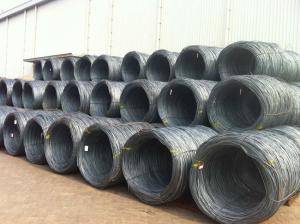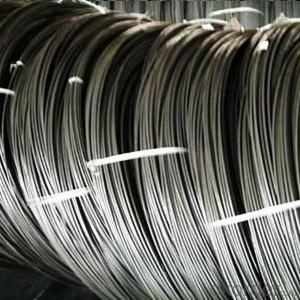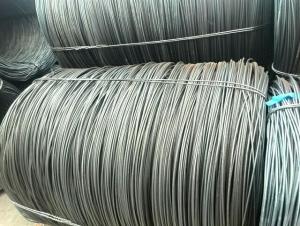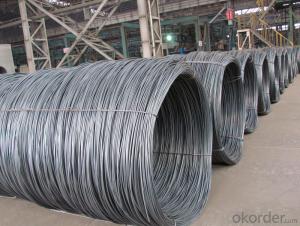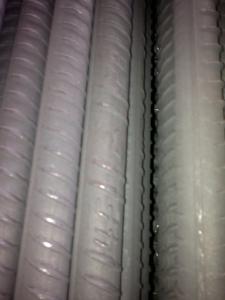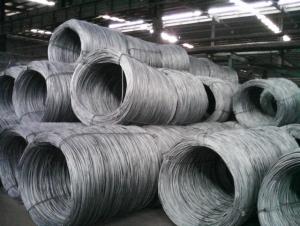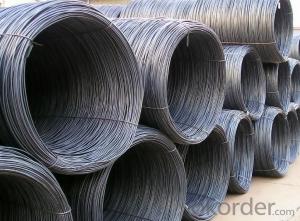Q195 Steel Wire Rod
- Loading Port:
- China Main Port
- Payment Terms:
- TT OR LC
- Min Order Qty:
- -
- Supply Capability:
- -
OKorder Service Pledge
OKorder Financial Service
You Might Also Like
Specifications of Wire Rod Q195:
Grade: Q195 Standard: GB
Diameter: 5.5mm, 6.5mm, 7mm, 8mm
Alloy or Not: Alloy
Technique: Hot Rolled Place of Origin: China Mainland
Chemical Composition:
Please kindly find our chemistry of our material based on Q195 as below for your reference:
Trademark | Rank | Chemical composition (quality score) % | | ||||
C | Si | Mn | S | P | | ||
| | |||||||
| ≤ |
| ≤ | ≤ | | ||
Q195 |
| 0.06-0.12 | 0.30 | 0.25 | 0.050 | 0.045 | |
Trademark | Rank | Pulling Test | | ||||
Bend PointΔs/Mpa | Tensile Strength | Elongation Ratioδ5% | | ||||
| | |||||||
Thickness (Diameter) /MM | Thickness (Diameter) /MM | | |||||
≤16 | 16-40 | | ≤16 | 16-40 | | ||
≥ | | ≥ | | ||||
Q195 |
| 195 | 185 | 315-390 | 33 | 32 | |
Usage and Applications of Wire Rod Q195:
After hot-rolled the products shaped into coil and delivery as finished product, including round, square,rectangular, hexagonal and so on. Since most of the products are round, it is generally called wire rod. Carbon steel wire rod is widely used in construction and manufacturing. Carbon steel wire rod is mainly used for reinforcement of reinforced concrete and welded structure or reprocessed (roberts , nail, etc.) materials, especially used to produce wire drawing, welding electrode, nails, spring, electronic, precise machinery parts and so on.
Packaging & Delivery of Wire Rod Q195:
Packaging Detail: products are packed in coil and then shipped by container or bulk vessel
Each coil weight: About 2.05MT
Delivery Detail: within 45 days after received deposit or LC.
Label: to be specified by customer, generally, each bundle has 1-2 labels
Trade terms: FOB, CFR, CIF
*If you would like to get our price, please inform us the size, standard/material and quantity. Thank you very much for your attention.
- Q: What are the standard bending requirements for steel wire rod?
- The bending requirements for steel wire rod vary depending on the industry or application in which it is used. However, there are commonly followed general guidelines and specifications. The diameter or gauge of the steel wire rod is a key factor in determining the bending requirements. Thicker wire rods require a larger bending radius to prevent excessive strain or deformation during bending. The type of steel used in the wire rod also affects the bending requirements. Different steels have varying levels of ductility and tensile strength, which impact the bending process. Adhering to the manufacturer's specifications and guidelines is crucial to avoid excessive stress or damage during bending. Industry standards and regulations may also dictate specific bending requirements for steel wire rods. For example, ASTM A510, established by the American Society for Testing and Materials (ASTM), provides guidelines for carbon steel wire rods in various applications. Ultimately, the bending requirements for steel wire rod depend on factors such as diameter, steel type, and industry standards. Consulting relevant specifications and guidelines is essential to ensure proper bending procedures, maintaining the wire rod's integrity and functionality.
- Q: How is steel wire rod used in the production of wire mesh sieves?
- Wire mesh sieves require steel wire rod as an essential component. The wire rod undergoes various processes, such as drawing, annealing, and coating, to improve its strength and durability. Once prepared, the steel wire rod is fed into a wire drawing machine to reduce its diameter to the desired size. This ensures uniform thickness and a smooth surface, which is crucial for subsequent manufacturing steps. After drawing, the wire is annealed to increase flexibility and remove any residual stresses. This makes it easier to work with and less likely to break during production. Next, the wire is coated with zinc or PVC to enhance its resistance to corrosion. This protective layer acts as a barrier, prolonging the wire's lifespan and maintaining its structural integrity. The coated wire is then woven or welded to create the wire mesh sieve. Weaving involves interlacing the wires in a crisscross pattern, while welding involves fusing the wires at their intersections using heat and pressure. The resulting wire mesh sieve is a versatile and reliable tool used in various industries. It is commonly employed for particle size analysis, filtration, and sorting applications. The steel wire rod used in its production ensures it can withstand high pressures and abrasion, making it suitable for demanding environments. In conclusion, steel wire rod plays a crucial role in the manufacturing process of wire mesh sieves. It undergoes drawing, annealing, and coating before being woven or welded to create the final product. The resulting wire mesh sieve is a robust tool used in a wide range of industries for particle analysis and filtration purposes.
- Q: How is steel wire rod used in the manufacturing of musical instruments?
- Steel wire rod is used in the manufacturing of musical instruments for various purposes. It is commonly employed in the construction of strings for instruments like guitars, pianos, and harps, providing the necessary tension and resonance. In addition to strings, steel wire rod is also used in the production of various components such as springs, valves, and keys, ensuring durability and functionality in the instruments. Its strength, flexibility, and consistency make steel wire rod an essential material in the creation of high-quality musical instruments.
- Q: What are the different types of steel wire rod annealing atmospheres?
- Depending on the desired outcome and specific requirements of the process, there are various types of annealing atmospheres for steel wire rods. These atmospheres differ in terms of the gases used and the conditions maintained during annealing. 1. Nitrogen Atmosphere: Steel wire rod annealing processes commonly utilize nitrogen gas. This inert gas protects the material from oxidation and decarburization. It creates a stable environment for consistent and controlled heat treatment. 2. Hydrogen Atmosphere: Another frequently used annealing atmosphere for steel wire rods is hydrogen gas. Hydrogen helps minimize surface oxidation and can remove surface contaminants or impurities, resulting in a clean and bright surface finish. 3. Vacuum Atmosphere: Vacuum annealing involves creating a low-pressure environment by removing air and other gases from the annealing chamber. This atmosphere prevents oxidation and provides precise control over the annealing process. Vacuum annealing is ideal for high-quality wire rods with minimal surface defects and improved mechanical properties. 4. Inert Gas Mixtures: In certain cases, a combination of inert gases like nitrogen and hydrogen may be used as an annealing atmosphere. This mixture offers the advantages of both gases, including protection against oxidation and impurity removal. The specific mixture and ratios depend on the desired outcome and material requirements. 5. Controlled Atmosphere Furnaces: Controlled atmosphere furnaces enable precise regulation of the annealing atmosphere by continuously monitoring and adjusting the gas composition. This allows for the optimization of annealing conditions to achieve desired material properties and surface finishes. It is important to consider the specific steel composition, desired properties, and end-use application of the wire rod when selecting the annealing atmosphere. By carefully choosing the appropriate atmosphere, steel wire rods can undergo a controlled heat treatment process that enhances their mechanical properties, surface quality, and overall performance.
- Q: What are the different microscopy techniques used for steel wire rod analysis?
- There are several microscopy techniques used for steel wire rod analysis, including optical microscopy, scanning electron microscopy (SEM), transmission electron microscopy (TEM), and atomic force microscopy (AFM). These techniques allow for the examination of the microstructure, surface morphology, elemental composition, and defects in steel wire rods, providing valuable information for quality control and material characterization purposes.
- Q: What are the different types of steel wire rod surface defect monitoring systems?
- There are various types of steel wire rod surface defect monitoring systems available in the market. Some common ones include laser scanners, optical inspection systems, electromagnetic systems, ultrasonic systems, and thermal imaging systems. These systems use different technologies to detect and monitor surface defects such as cracks, scratches, and irregularities in steel wire rods, ensuring product quality and integrity.
- Q: How is steel wire rod coated for corrosion protection?
- Steel wire rod is coated for corrosion protection through a process called galvanization. This involves immersing the wire rod in a bath of molten zinc, which forms a protective layer over the surface of the steel. The zinc coating acts as a barrier, preventing contact between the steel and corrosive elements, thereby significantly reducing the risk of corrosion.
- Q: How is steel wire rod used in the production of wire displays?
- Steel wire rod is used as the primary raw material in the production of wire displays. It is shaped, cut, and bent into various forms to create the frames, shelves, hooks, and other components of wire displays. The high strength and durability of steel wire rod make it ideal for supporting and displaying products in retail stores, exhibitions, and other promotional events.
- Q: What are the common production processes for silicon-coated steel wire rod?
- The common production processes for silicon-coated steel wire rod typically involve cleaning and pickling the steel wire rod, applying a silicon coating through a continuous casting process, and then cooling and coiling the coated wire rod.
- Q: How are steel wire rods used in the production of wire springs for mechanical devices?
- Steel wire rods are an essential component in the production of wire springs for mechanical devices. These wire rods are made of high-quality steel that possesses excellent strength and elasticity properties. To begin, the steel wire rods are first processed through a series of manufacturing steps. This includes cleaning the rods to remove any impurities and then heating them to a specific temperature to make them more malleable. Once heated, the rods are passed through a series of rollers, which gradually reduce their diameter to the desired size. This process, known as wire drawing, ensures that the steel wire rods are of the correct thickness for the production of wire springs. After the wire drawing process, the steel wire rods are further treated to enhance their properties. This may involve heat treatment processes such as annealing or quenching, which can increase the strength and elasticity of the wire. Additionally, the rods may also undergo surface treatments such as electroplating or coating to improve their corrosion resistance. Once the steel wire rods are prepared, they are then used to manufacture wire springs for mechanical devices. Wire springs are widely used in various applications, ranging from automotive suspension systems to household appliances. The wire rods are fed into specialized machinery, where they are coiled or bent to form the desired shape of the spring. The machinery applies tension and pressure to the wire rods, causing them to deform and take on the spring shape. The quality and properties of the steel wire rods play a crucial role in determining the performance and durability of the resulting wire spring. In summary, steel wire rods are essential raw materials in the production of wire springs for mechanical devices. They undergo various manufacturing processes to ensure the desired strength, elasticity, and corrosion resistance. Once prepared, the wire rods are used in specialized machinery to form wire springs, which are critical components in a wide range of mechanical devices.
Send your message to us
Q195 Steel Wire Rod
- Loading Port:
- China Main Port
- Payment Terms:
- TT OR LC
- Min Order Qty:
- -
- Supply Capability:
- -
OKorder Service Pledge
OKorder Financial Service
Similar products
Hot products
Hot Searches
Related keywords














